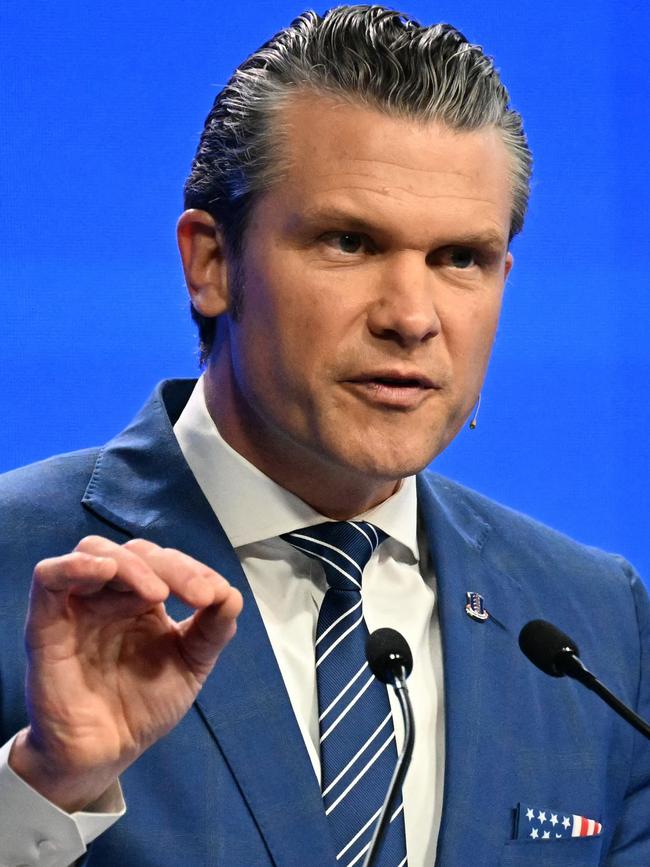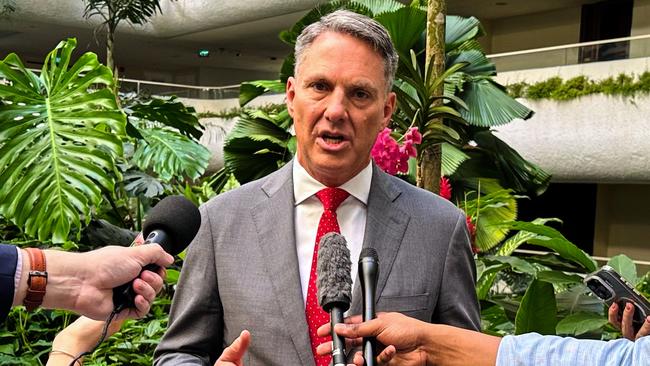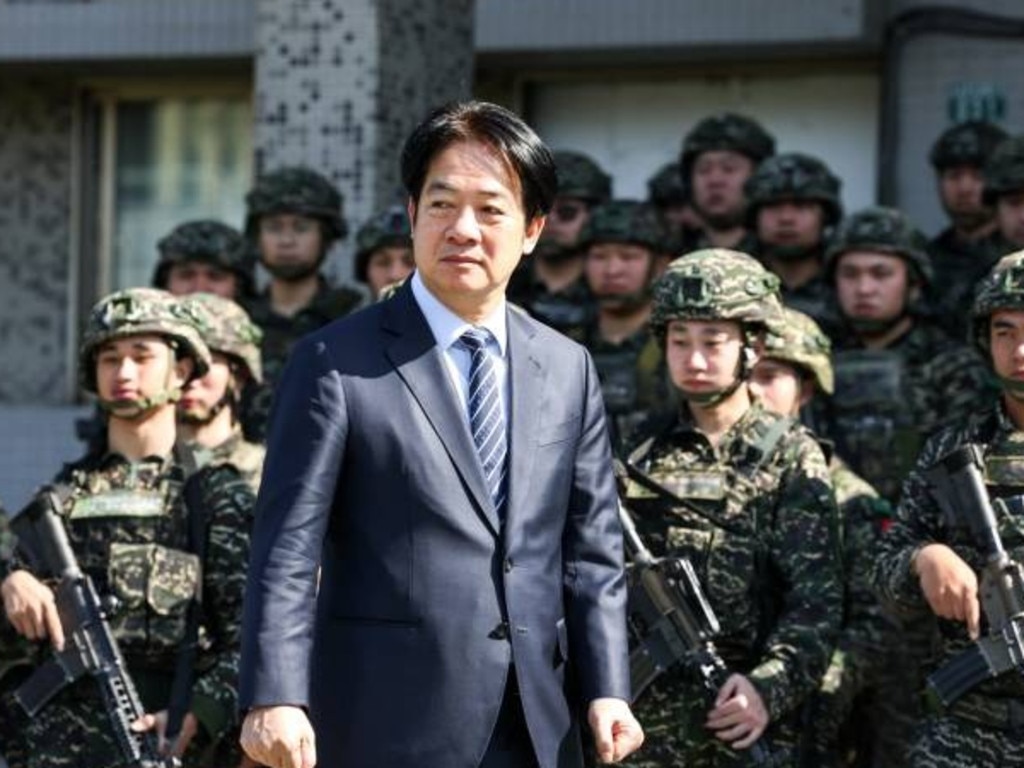Taiwan tipping point as US-Australia forces prepare for war
Australia and the US have elevated military exercises to a war footing amid China’s unprecedented armed forces build-up and fears Xi Jinping could imminently invade Taiwan.

Australia and the US have elevated military exercises and security agency co-operation to a war footing amid China’s unprecedented armed forces build-up in the Indo-Pacific and fears Xi Jinping could imminently move to invade Taiwan, triggering a major global conflict.
Ahead of Anthony Albanese’s first in-person meeting with Donald Trump at the G7 summit in Canada, relations between Washington and Beijing sank to a new low on the weekend amid rising tensions between the superpowers over military expansion, Taiwan and trade tariffs.
The new flashpoint in US-China relations was sparked when US Defence Secretary Pete Hegseth warned Beijing was preparing to potentially use military force to “alter the balance of power in the Indo-Pacific” and that Mr Xi had ordered his armed forces to be capable of invading Taiwan by 2027.
Mr Hegseth’s speech, at the Shangri-La Dialogue in Singapore, which was immediately attacked by Chinese officials who cautioned the US to not “play with fire” on Taiwan, came amid an ongoing build up of American military personnel in Australia.
The US has been strengthening its military presence in northern Australia and enhancing collaboration with Australian defence and security agencies as it prepares for the prospect of regional conflict with China. With close to 2500 marines rotating through the Northern Territory, the US military presence in Australia has hit its highest levels since the end of World War II.
Revealing Australia has locked in agreements with the US on ammunition, rockets and guided weapons, Mr Hegseth said the US Army would soon conduct “its first live-fire test of its mid-range capability system in Australia”.
“This will be the first time that system is fired west of the International Date Line, the first time it’s been tested on foreign soil. Deployments like this represent a commitment to the region, and there are many more planned,” Mr Hegseth said.
More than 30,000 military personnel from 19 nations will participate in the 11th Exercise Talisman Sabre, led by Australia and the US, from July 13 to August 4. The largest ever Talisman Sabre will be staged at sites in Australia and, for the first time, Papua New Guinea, consisting of live-fire and field training exercises, force preparation activities, amphibious landings, ground force manoeuvres, air combat and maritime operations.
In a new report titled The World According to Xi Jinping, Lowy Institute China expert Richard McGregor said “a confrontation with Washington could happen quickly or in slow motion”.
“So long as Xi remains in power and the United States maintains a significant military presence in Asia, ever intensifying competition is on the cards,” he wrote.
As relations between Mr Trump and Mr Xi sour, Mr Albanese will be forced to balance Australia’s security relationship with the US and economic ties with China when he meets the US President on the sidelines of the G7 summit, hosted by Canadian Prime Minister Mark Carney from June 15-17.
The Prime Minister’s meeting with Mr Trump is expected to focus on geostrategic and security challenges posed by China, defence spending, critical minerals and tariffs.
Mr Albanese, who has forged closer ties with Mr Xi since winning the 2022 election and secured the removal of Chinese trade bans on local products, on Sunday said Australia’s position on Taiwan had not changed.
“Our position with regard to Taiwan is very clear, has been for a long period of time, which is a bipartisan position to support the status quo,” Mr Albanese said.


After Mr Hegseth last week directly urged Defence Minister Richard Marles to boost Australia’s defence budget, Mr Albanese said “we’ll determine our defence policy and we’ve invested across the forwards an additional $10bn in defence”.
Strategic Analysis Australia director Peter Jennings, a former Defence Department deputy secretary, said Mr Trump would likely “press Albanese to lift defence spending”.
“Defence spending is currently 2.05 per cent of gross domestic product, on a languid path to reach 2.4 per cent in eight years. No one outside of government (and in fact, not many inside government) believes that is an adequate response to our strategic situation,” Mr Jennings said.
In a provocative show of force ahead of the May 3 election, Chinese warships circumnavigated Australia and conducted live-fire exercises in the Tasman Sea without warning, while a spy ship lurked off the coast.
Mr Marles on Sunday said “what we have seen from China is the single-biggest increase in military capability and build-up … by any country since the end of the Second World War”.
“And it’s not just the size of the military build-up, it’s the fact that it is happening without strategic reassurance. It’s happening without a clear strategic intent on the part of China,” Mr Marles said.
After gaining access to US Marine Corps operations in Australia, CBS News last week reported on joint exercises with Australian and Japanese troops conducted as part of preparations against Chinese aggression.
Brigadier Ben McLennan, commander of the Australian Defence Force 3rd Brigade, told CBS News they were preparing for the worst possible outcome.
“Every time you commit to an exercise like this, it is a rehearsal – and you treat it as your last opportunity to do so before war arrives. A rehearsal for a war the likes of which we haven’t seen since the Second World War,” he said.

Mr Hegseth used his Shangri-La Dialogue speech to amplify risks posed by the Chinese Communist Party regime and growing military co-operation with allies including Australia.
“It has to be clear to all that Beijing is credibly preparing to potentially use military force to alter the balance of power in the Indo-Pacific. We know. It’s public that Xi has ordered his military to be capable of invading Taiwan by 2027,” he said.
“The PLA is building the military needed to do it. Training for it every day. And rehearsing for the real deal.
“To be clear: any attempt by communist China to conquer Taiwan by force would result in devastating consequences for the Indo-Pacific and the world. There’s no reason to sugarcoat it. The threat China poses is real. And it could be imminent.”
In response to Mr Hegseth, a Chinese foreign affairs ministry spokesperson said “the US should never imagine it could use the Taiwan question as leverage against China”.
“The Taiwan question is entirely China’s internal affair. The US must never play with fire on this question. China urges the US to fully abide by the one-China principle,” the Chinese official said.
Chinese authorities last month attacked Australia for trying to create “trouble” following joint military exercises in the South China Sea conducted alongside the US and Philippines.
In February, the Royal Australian Navy, US Navy and the British Royal Navy conducted exercises in the South China Sea to “strengthen collaboration at sea” between the AUKUS partners. Australian, US and Japanese defence personnel in December ran Exercise Yama Sakura at sites in all three countries, which involved 6800 troops.
Mr Marles and Mr Hegseth on Saturday held trilateral talks with Japanese Defence Minister Nakatani Gen in Singapore to discuss the “severe and complex security environment in the Indo-Pacific and the importance of the Australia-Japan-United States partnership to maintain and reinforce a free and open Indo-Pacific”.
Ahead of Mr Albanese meeting Japan Prime Minister Shigeru Ishiba in Canada, a Japanese Mogami-class frigate will berth at HMAS Coonawarra Naval Base on Thursday for a three-day stop.
The Japanese government is pushing hard for Australia to buy $10bn worth of new Mogami frigates and position its shipbuilder Mitsubishi Heavy Industries as the firm favourite in the contest with Germany’s ThyssenKrupp Marine Systems.
The Albanese government will make a final decision on its SEA3000 general purpose frigate tender later this year. The plan involves the purchase of 11 frigates, with the first three built offshore and the remainder at Henderson in Perth.
In his Lowy Institute special feature, Mr McGregor said Mr Trump’s return to the White House would likely harden China’s foreign policy and military ambitions.
“China will keep investing heavily in technology to gain leverage over the US and its allies, both in industry and the military. It will continue to try to marginalise Washington, particularly in Asia,” he wrote.
“Relations with Vladimir Putin’s Russia will be strengthened. The focus on building alternative global power centres among emerging middle powers and developing countries will be accelerated.”







To join the conversation, please log in. Don't have an account? Register
Join the conversation, you are commenting as Logout